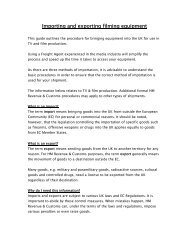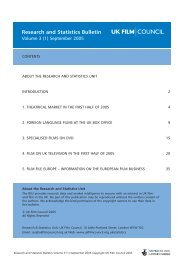Film theft in the UK - Future of Copyright
Film theft in the UK - Future of Copyright
Film theft in the UK - Future of Copyright
Create successful ePaper yourself
Turn your PDF publications into a flip-book with our unique Google optimized e-Paper software.
10<br />
4 <strong>Film</strong> <strong><strong>the</strong>ft</strong> <strong>in</strong> <strong>the</strong> <strong>UK</strong>:<br />
<strong>the</strong> current climate<br />
The bus<strong>in</strong>ess <strong>of</strong> film<br />
The film <strong>in</strong>dustry is based on a bus<strong>in</strong>ess model<br />
which <strong>in</strong>volves a complex series <strong>of</strong> release<br />
w<strong>in</strong>dows. This model maximises pr<strong>of</strong>its by<br />
exploit<strong>in</strong>g film content via three key <strong>in</strong>terl<strong>in</strong>ked<br />
dimensions: time, technology and geography.<br />
• Time is exploited through sequential release<br />
w<strong>in</strong>dows tied to technological platform or<br />
format (essentially, when and how <strong>the</strong> film<br />
becomes available)<br />
• Geography is exploited through rights tied<br />
to territory and language (that is, where <strong>the</strong><br />
film becomes available), based on <strong>the</strong> territorial<br />
nature <strong>of</strong> copyright.<br />
As technology stands currently, this means that<br />
a film premieres first <strong>in</strong> <strong>the</strong> c<strong>in</strong>ema (<strong>the</strong><br />
<strong>the</strong>atrical w<strong>in</strong>dow), <strong>the</strong>n makes its way onto<br />
DVD, VHS video and <strong>in</strong> some territories Video-<br />
CD (<strong>the</strong> video w<strong>in</strong>dow), before progress<strong>in</strong>g<br />
onto television – first on pay-per-view and<br />
subscription television (<strong>the</strong> pay-TV w<strong>in</strong>dow),<br />
<strong>the</strong>n onto free-to-air television. 3 In each<br />
<strong>in</strong>stance, exclusive access to a new film ahead<br />
<strong>of</strong> <strong>the</strong> next ‘w<strong>in</strong>dow’ <strong>in</strong> <strong>the</strong> value cha<strong>in</strong> has<br />
been considered by <strong>the</strong> <strong>in</strong>dustry to be critical to<br />
maximis<strong>in</strong>g turnover.<br />
It also means that a film becomes available <strong>in</strong><br />
some territories earlier than it does <strong>in</strong> o<strong>the</strong>rs.<br />
For practical reasons, most films are released<br />
earlier <strong>in</strong> <strong>the</strong> US (<strong>the</strong> largest s<strong>in</strong>gle revenue<br />
generat<strong>in</strong>g country for film) than Europe or<br />
<strong>in</strong>deed <strong>the</strong> rest <strong>of</strong> <strong>the</strong> world. However, over<br />
recent years <strong>the</strong>re has been a steady reduction<br />
<strong>in</strong> <strong>the</strong> time lag between <strong>the</strong> US <strong>the</strong>atrical<br />
release and <strong>the</strong>atrical release elsewhere – and<br />
<strong>in</strong>deed some movies are now released more or<br />
less simultaneously <strong>in</strong> all key global territories.<br />
This bus<strong>in</strong>ess model has been developed over<br />
decades as a commercially viable way <strong>of</strong><br />
generat<strong>in</strong>g a sufficient return on <strong>in</strong>vestment to<br />
protect filmmakers aga<strong>in</strong>st <strong>the</strong> risks <strong>in</strong>herent <strong>in</strong><br />
br<strong>in</strong>g<strong>in</strong>g new movies to <strong>the</strong> market, many <strong>of</strong><br />
which do not make a pr<strong>of</strong>it. Indeed, not every<br />
project that is developed becomes a motion<br />
picture and not every film that is produced is<br />
pr<strong>of</strong>itable. Accord<strong>in</strong>g to <strong>the</strong> MPA,<br />
approximately ten projects are developed for<br />
every major film project that is “greenlit” (ie, a<br />
decision is made to produce a motion picture<br />
based on that project), and four out <strong>of</strong> every<br />
ten films do not recoup <strong>the</strong>ir total production<br />
and distribution costs.<br />
Production costs are not recouped from<br />
<strong>the</strong>atrical revenues alone 4 ; ra<strong>the</strong>r production<br />
costs, as well as overhead and <strong>the</strong> costs <strong>of</strong><br />
those projects that have been developed but<br />
not produced, are recouped from all media and<br />
markets <strong>in</strong> which <strong>the</strong> film is exploited. If any<br />
medium or market is cannibalised or destroyed<br />
by piracy, <strong>the</strong> loss is felt not only <strong>in</strong> that market,<br />
but <strong>in</strong> all subsequent distribution markets, and<br />
<strong>the</strong> amount <strong>of</strong> money available for production<br />
<strong>of</strong> <strong>the</strong> picture at issue (not to mention<br />
recoupment <strong>of</strong> development costs and losses<br />
on non-pr<strong>of</strong>itable pictures) are similarly

















